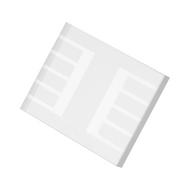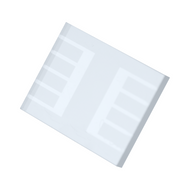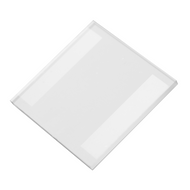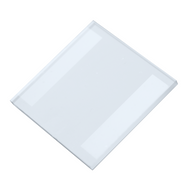Four-Point Probe
Electrical Characterization, Lab Equipment,Easy and Reliable Characterization of Your Thin Films
Fast and accurate sheet resistance measurements for a wide range of materials
Overview | Specifications | Software | Features | Gallery | In the Box | Related Products | Resources and Support
Quick and easy measurement of sheet resistance, resistivity, and conductivity of thin films. Choose the right probe type for your samples:
- The soft-tipped probes are spring-loaded with rounded contacts. Take high quality surface measurements without damaging delicate samples, ideal for characterizing nanometer-thin polymer films.
- The sharp-tipped probes are designed to pierce insulating oxide layers for reliable measurement of materials such as silicon.
Both models can fit seamlessly into any lab environment thanks to their compact and self-contained design, while the Plus model can take measurements in setups without a PC. Built with the Ossila Source Measure Unit at its core, the wide current range is suitable for a variety of measurements. Choose the four-point probe for rapid and reliable material characterization.
The Ossila Four-Point Probe was used by NASA in sheet resistance measurements to investigate the effects of space exposure on indium tin oxide coatings.
Choose Your Probes
For effective sample measurements
Free Software
For easy sheet resistance measurements
Wide Current Range
For versatile sample measurements
Upgrade to Plus
In-built display for quick measurements
Quick Measurements with the Four-Point Probe Plus
Characterize your samples without connecting to a PC. The Four-Point Probe Plus includes embedded software that is easily controlled by the LED screen and keypad.
The system can independently measure the sheet resistance and, after inputting the dimensions and thickness, the conductivity and resistivity of a sample. It also provides real-time display of both the current and voltage between the outer pins and the voltage between the inner pins. For more complex experiments, this model still includes free PC software so you can record your data.

Key Specifications
| Voltage Range | ±100 μV – ±10 V |
|---|---|
| Current Ranges | ±20 μA – ±200 mA (5 ranges) |
| Sheet Resistance Range | 100 mΩ/sq – 10 MΩ/sq |
For more information on the current ranges, see our SMU specifications.
Probe Types
The soft-tipped probes reduce the potential of damaging delicate thin films with rounded tips and a larger surface area with a radius of 0.24 mm. The gold-plated probes are mounted on springs to allow them to retract into the probe head when making contact with the sample. This design spreads out the downward force and ensures that a uniform force of 60 grams is applied to the sample. The soft-tipped probes are not suitable for silicon or other materials which naturally form insulating oxide layers.
The sharped-tipped probes are designed for materials with naturally forming oxide layers, with a tip diameter of 0.08 mm. The nickel-plated tungsten carbide probes can apply a maximum force of 197.43 gf to pierce the insulating layer for reliable sample measurements.
Please note: Your Ossila Four-Point Probe will require screen firmware version 1.1.0 or newer to use the sharp-tipped probe head. You can download the latest firmware from our website.
Sheet Resistance
| Sheet Resistance | SMU Accuracy* | Precision | Measured at Range |
|---|---|---|---|
| 100 mΩ/sq | ±8% | ±3% | 200 mA |
| 1 Ω/sq | ±2% | ±0.5% | 200 mA |
| 10 Ω/sq | ±1% | ±0.5% | 200 mA |
| 100 Ω/sq | ±1% | ±0.05% | 20 mA |
| 1 kΩ/sq | ±1% | ±0.03% | 20 mA |
| 10 kΩ/sq | ±1% | ±0.02% | 2000 µA |
| 100 kΩ/sq | ±2% | ±0.05% | 200 µA |
| 1 MΩ/sq | ±8% | ±0.5% | 20 µA |
| 10 MΩ/sq | ±30% | ±5% | 20 µA |
*The probe head can introduce up to 4% additional measurement error.
Software
Your four-point probe can be controlled using a PC, running our free, user-friendly Ossila Sheet Resistance Lite software. With the Plus model, you can also use the embedded software on the inbuilt data display. Both pieces of software can calculate appropriate geometrical correction factors for the sample geometry and the resistivity and conductivity of the sample to allow for extensive, accurate electrical characterization of materials (if you would like to record your data, you will need to use the Ossila Sheet Resistance Lite software).

The Sheet Resistance Lite software is supplied on the included USB memory stick along with a copy of the user manual and QC data. In addition, the latest version is always available to download for free from our website.
The Sheet Resistance Lite software saves data to comma-separated value (.csv) files, facilitating importing the data into your preferred analysis software. Advanced settings give you greater control over the measurment, allowing you to set voltage and current limits, perform negative polarity measurements, or use probes with different spacings.
Sheet Resistance Lite Software Requirements
| Operating System | Windows 10 or 11 (64-bit) |
|---|---|
| CPU | Dual Core 2 GHz |
| RAM | 2 GB |
| Available Hard Drive Space | 270 MB |
| Monitor Resolution | 1440 x 900 |
| Connectivity | USB 2.0, or Ethernet (requires DHCP) |
Four-Point Probe Features
Soft- or Sharp-Tipped Probes
Choose the right probe type for your sample. With spring-loaded contacts, the soft-tipped probes spread the downward force by retracting into the head to effectively measure delicate samples. The sharp-tipped probes are designed to apply a higher maximum force to pierce insulating oxide layers for accurate measurements.
Quick Measurements (Plus model only)
The inbuilt data display includes a bright LCD display and tactile keypad, allowing you to characterize your samples without needing to connect to a PC. Simply plug in the four-point probe, raise your sample so that it makes contact with the probes, and press the OK button.
High Accuracy
Positive and negative polarity measurements can be performed to calculate the average sheet resistance between positive and negative currents. This eliminates any voltage offsets that may have occurred, hence increasing the accuracy of your measurements.
Wide Current Range
Our four-point probe is capable of delivering currents between 1 μA and 200 mA, and can measure voltages from as low as 100 μV up to 10 V. The system can measure sheet resistances in the range of 100 mΩ/sq to 10 MΩ/sq, enabling the characterization of a wide range of materials.
Characterize Large Samples
The large stage area means you can characterize larger samples up to a 6 inch (152.4 mm) diameter. Larger samples are less reliant on correction factors and provide more accurate measurements when characterizing your materials.
Linear Translation Stage
With micrometer height control for simple and controlled soft sample contact. The manual knob makes it easy to achieve good electrical contact each time. Plus, the non-slip stage keeps your samples steady and ensures your delicate samples are not damaged by movement during characterization.
Four-Point Probe Gallery*
*Photos include both Original and Plus models
Additional Specifications
Physical Specifications
| Four-Point Probe Dimensions (W x H x D) | 145 mm x 150 mm x 240 mm (5.71" x 5.91" x 9.45") | |
|---|---|---|
| Soft-tipped probes | Sharp-tipped probes | |
|---|---|---|
| Probe Spacing | 1.27 mm (0.05") | 1.6 mm (0.063") |
| Rectangular Sample Size Range |
Long edge minimum: 5 mm (0.20") Short edge maximum: 152.4 mm (6") |
Long edge minimum: 6 mm (0.24") Short edge maximum: 152.4 mm (6") |
| Circular Sample Size Range (Diameter) | 5 mm – 152.4 mm (0.20" – 6.00") |
6 mm – 152.4 mm (0.24" – 6.00") |
| Maximum Sample Thickness | 8 mm (0.31") | 5 mm (0.2") |
Resistivity and Conductivity Range
As the system measures the sheet resistance of a sample, a general range of measurable resistivities or conductivities cannot be given. This is because the measurable resistivity range depends on the thickness of the sample being tested. The resistivity of a sample can be calculated from its sheet resistance and thickness using the following equation:

The system is capable of measuring between 100 mΩ/sq and 10 MΩ/sq, so if we use these values in the formula above with a sample 50 nm thick, then the resistivity (conductivity) range that can be measured by the system will be 5 nΩ.m to 500 mΩ.m (2 S/m to 200 MS/m). If the sample is 400 µm thick, then the resistivity (conductivity) range of the system is 40 µΩ.m to 4 kΩ.m (250 µS/m to 25 kS/m). Below is a table of the resistivity and conductivity ranges of the system for samples with thicknesses of different orders of magnitude:
| Coating Thickness | Resistivity Range | Conductivity Range |
|---|---|---|
| 10 nm | 1 nΩ.m – 100 mΩ.m | 10 S/m – 1 GS/m |
| 100 nm | 10 nΩ.m – 1 Ω.m | 1 S/m – 100 MS/m |
| 1 µm | 100 nΩ.m – 10 Ω.m | 100 mS/m – 10 MS/m |
| 10 µm | 1 µΩ.m – 100 Ω.m | 10 mS/m – 1 MS/m |
| 100 µm | 10 µΩ.m – 1 kΩ.m | 1 mS/m – 100 kS/m |
| 1 mm | 100 µΩ.m – 10 kΩ.m | 100 µS/m – 10 kS/m |
In the Box
- Ossila Four-Point Probe with head and stage
- Integrated source measure unit
- Inbuilt data display with sheet resistance measurement capability (T2001A5 only)
- 60 x 60 mm (2.36" x 2.36") glass substrate coated with 400 – 450 nm of FTO
- Power adapter (24 VDC)
- USB Driver with QC test report & QC test data
- USB-B cable
Accessories and Related Products
Resources and Support
 How to Measure Sheet Resistance using a Four-Point Probe
How to Measure Sheet Resistance using a Four-Point Probe
This guide gives an overview of how to use the Ossila Four-Point Probe System, as well as some general tips and tricks for measuring sheet resistance.
Read more...









